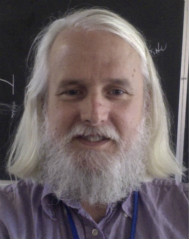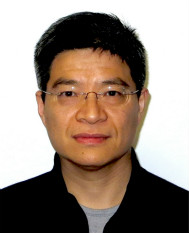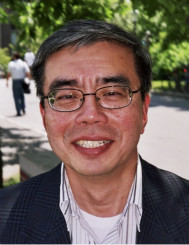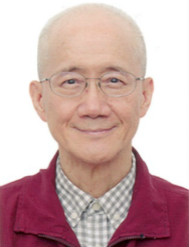



Topic: Notes on Spheromak Compression+
Senior Scientist at IPP, active in fusion-oriented plasma physics and astrophysics since my phD of 1985 (University of Maryland, USA). I have been at IPP since June 1988, I have been a regular visitor to USTC (Hefei) since 2014.

Topic:Progress and Trends on Fusion Power Plant Studies+
Deputy chief engineer of Center of Fusion Science, SWIP. Graduated from Shanghai Jiaotong university major in nuclear reactor engineering. Have been engaged in the theory and design of fusion reactors for 35 years.

Topic: Spherical Tori: Past, Present and Future+
Prof. Gao is Professor and Vice-chair at Department of Engineering Physics, Tsinghua University. He received the B.S. degree in 1997 and Ph.D. degree in 2002, both from Tsinghua University. His professional interests include: Plasma instabilities, turbulence transport and coherent structure, plasma-wave interaction, and spherical tokamak physics. He has served the PIs of over ten research projects of NSFC, MoST and MoE of China; and published more than 100 peer-refereed papers. He won Tsai Shi-Tong Plasma Physics Award (2003), National Excellent Doctoral Dissertation Award (2004), New Century Excellent Talents, MoE (2008), Excellent Youth Award, Fok Ying-Tong Education Fundation and MoE (2012), National Science Fund for Outstanding Young Scholars (2013), National High Level Talents Special Support Plan (2016).

Dr. Jaeyoung Park is the President and Chief Scientist at Energy Matter Conversion Corporation. Since 2007, Dr. Park has been developing compact fusion reactors based on proprietary Polywell fusion technology. With the support from the US Navy, he and his team of 25 scientists and engineers successfully demonstrated the enhanced confinement of energetic electrons in a high pressure magnetic cusp system, a critical breakthrough for the Polywell technology. Since then, Dr. Park has worked on a first-principles plasma simulation code to validate the experiments and to accelerate the reactor development. Dr. Park has a Ph.D. in Astrophysical Sciences from Princeton University and was previously a principal investigator for fusion neutron generation research at Los Alamos National Laboratory.

Topic: Advanced Fuels for Compact Fusion Concepts+
John F. Santarius received his BS from Caltech and his PhD from the University of Texas at Austin. Now at the University of Wisconsin-Madison, he is Associate Director for Alternate Applications and Concepts in the Fusion Technology Institute and a Research Professor in the Department of Engineering Physics. His major research emphases focus on advanced fuel fusion power plants, plasma physics and engineering for magnetic fusion, space propulsion, space resources, and inertial-electrostatic confinement fusion for clandestine materials detection and other applications. Dr. Santarius taught the UW courses Fusion Technology, Plasma Space Propulsion, Astrodynamics, and Resources from Space. He served as guest editor for special D-3He issues of the ANS journal Fusion Technology and on the IEEE Fusion Technology Standing Committee.

Topic:Fusion Energy Development Status in Korea
Kijung JUNG has been worked in the area of radio-active waste treatment, decontamination and decommissioning, and spent fuel management for more than 20 years at the Korea Atomic Energy Research Institute.
In 2006, he was requested to move to the National Fusion Research Institute (NFRI) and since then he takes responsibility of the ITER project in Korea. He is Director General of the Korea Domestic Agency (KO-DA) for ITER project since 2006.

Topic: Conic Imploding Magnetic Inertia Fusion Concept+
Dr. Lei is an associate professor in theoretical physics, and the director of high-performance computer center in Beijing University. He had a B.E. degree from Hefei University of Technology in 1989, a Ph.D. in theoretical physics, Beijing University. He spent two years as a post-doc in the Institute of Theoretical Physics, Academy of Sciences, China, and was a visiting scholar in University of Nebraska-Lincoln, University of California-Irvine, Los Alamos National Laboratory for about 2 years. He worked on quantum physics, plasma physics, advanced nuclear energy, fusion energy, and high performance computing.

Topic: What Can and cannot be Expected from the Tokamak Fusion+
Leonid Zakharov from the Princeton University, was awarded the status of Fellow in the American Physics Society, after they were nominated by their Division of Plasma Physics in 2007, for contributions to the theory and numerical calculation of magnetohydrodynamic equilibria, stability, and transport in toroidal plasma confinement devices and for innovative ideas concerning the development of a lithium walled tokamak as an approach to an economic reactor.

Topic: Confinement Properties of FRC as a Compact Fusion Reactor
I use first-principles massively parallel simulations on the world’s fastest supercomputers to study turbulent transport in fusion plasmas, which have led to physics discovery in turbulence self-regulation by zonal flows, transport scaling, wave-partical decorrelation, energetic partical transport, and Alfven eigenmodes in fusion plasmas. As part of US Department of Energy (DOE) Scientific Discovery through Advanced Computing (SciDAC) initiative, I lead the Center for Integrated Simulation of Energetic Particles (ISEP), a consortium of University of California, Irvine (UCI), General Atomics (GA), and national laboratories PPPL, ORNL, LLNL, LBNL. I lead a DOE Center for Accelerated Application Readiness (CAAR) project, a consortium of UCI, Princeton University (PU), ORNL, and hardware vendors IBM and NVDIA to optimize a flagship fusion code GTC on the emerging exascale supercomputers.

Topic: Where Material Dares to Go under Fusion Extreme Conditions+
Professor Lu Guanghong was granted B.S. degree in 1991 and M.S. degree in 1994 in Jilin University, and Ph.D. in 2001 in University of Tokyo. He was employed as a JSPS Foreign Researcher from 2001 to 2003 in University of Tokyo, and a research professor from 2003 to 2006 in University of Utah. From 2006, he is serving as a full professor and employed as a Yangtse River Scholar in 2015 in School of Physics, Beihang University. His research interest focuses on structure and properties of metallic materials both computationally and experimentally towards the application of advanced nuclear energy systems. He has published more than 100 peer-review papers including 3 reviews, 4 PRLs, 15 PRB/APL, 12 Nuclear Fusion, and more than 20 J Nucl Mater.

Topic: Fusion Research in ITER Era+
Dr. Mitsuru Kikuchi is a senior expert at the Naka Fusion Institute, Fusion Research and Development Directorate, National Institutes for Quantum and Radiological Science and Technology . He joined JAERI in 1981 and was director of JT-60 and supreme researcher in Naka Fusion Institute. He has held visiting professorships at Kyoto University, Kyushu University and the Chinese Academy of Sciences. He has served as chairman of the Board of Editors of Nuclear Fusion. He is chair of the Division of Plasma Physics of the Association of Asia Pacific Physical Societies and guest professor of Osaka University (Japan) and visiting professor of Southwestern Institute of Physics (China) and the Modern Physics Institute at Fudan University (China). He received his Doctor of Philosophy in Engineering in 1981 from the University of Tokyo.

Topic: Choices Between One Alpha and Three Alphas
Qin Hong is a professor at the University of Science and Technology of China (USTC), and a principal research physicist and a lecturer with the rank of professor at the Princeton Plasmas Physics Laboratory. Currently, he serves as the director of the Center for Magnetic Fusion Theory of Chinese Academy of Sciences. His previous community service roles include the deputy theory head of the U. S Virtual National Lab on Heavy Ion Fusion, and the executive dean of the School of Nuclear Science and Technology at USTC. He received his B.S in 1990 from Peking University and Ph.D. in 1998 from Princeton University. His research interests include theoretical and computational plasma physics, accelerator physics, and mathematical physics. He was award the U. S. Presidential Early Career Award for Scientists and Engineers and the U.S. Department of Energy Office of Science Early Career Scientist and Engineer Award in 2004. Recently, he pioneered and established the research field of structure-preserving geometric algorithms for plasma physics.

Topic: The Spherical Tokamak as a Compact Fusion Reactor Concept+
The head of boundary physics operations for the National Spherical Torus Experiment-Upgrade (NSTX-U) and deputy head of research operations. Also a co-principal investigator of the Lithium Tokamak Experiment (LTX). A fellow of the American Physical Society and a recipient of the Kaul Foundation Prize for Excellence in Plasma Physics Research. Has supervised the research of many students in the PPPL Program in Plasma Physics in the Department of Astrophysical Sciences at Princeton University.

Topic: Progress, Progress, Promise, and Uses of Small, Clean FRC Fusion Reactors+
Samuel A. Cohen, with BS and PhD degrees from MIT, is the director of the Program in Plasma Science and Technology at Princeton University, principal research physicist at PPPL, and lecturer with the rank of professor in the Department of Astrophysical Sciences at Princeton. He is a Telluride Scholar, winner of the American Physical Society Award for Distinguished Teaching, and a fellow of the APS. His research interests are directed at developing small clean fusion reactors of the FRC type, with applications in space propulsion and terrestrial power generation.

Topic: AC Compression Tokamak: A New Way to Fusion Reactor
phD in Plasma diagnostics and experiment in Institute of Plasma Physics, Chinese Academy of Sciences (ASIPP); After his phD, he became an
Assistant Research Professor in ASIPP. Post-doc in Max-Planck-Institut für
Plasmaphysik for two years in Germany. From 2010 to 2015, he was a Visiting Researcher in National Fusion Research Institute in Korea (NFRI). He is the Visiting Professor in University of Science and Technology of China (USTC) and also the Researcher and Professor in Seoul National University in Korea (SNU). His work mainly related to the position in Experimental Plasma Physics and Nuclear Fusion. He has a 20-year’s R&D experience on plasma experiments and optical spectroscopy. He participated in plenty of projects including HT-7, ASDEX upgrade, EAST, KSTAR, VEST.

Topic: Design of a One Tesla Spherical Tokamak Optimized for Merging+
Dr. Tan is in charge of the SUNIST spherical tokamak (ST). In recent years, Dr. Tan upgraded all the power supplies of the magnetic field coils, re-designed the control system of the device, using most recent techniques. These efforts doubled the parameters of SUNIST. The academic field of Dr. Tan includes non-inductive startup and current drive in STs. He successfully explained a widely observed behavior during electron cyclotron wave startup in STs. Dr. Tan also insterested in fast MHD properties. His group firstly observed a rapid burst of toroidal Alfven eigenmodes during minor disruptions. Currently, Dr. Tan is designing a new ST, SUNIST-2.

Topic: Challenges in Support of Steady-State Tokamak Operation for Fusion Reactor+
Dr. WAN Baonian has been working on tokamak plasma experiment and diagnostics development for more than 30 years. He leads the experiments on two generation superconducting tokamaks, HT-7 and EAST. His research focus on development of advanced steady-state high performance tokamak operation modes, which covers on heating and current drive, turbulence and transport, equilibrium and instabilities, etc.

Topic : Gyrokinetic Simulation of Impurity Turbulent Transport in Tokamaks+
Professor Yong Xiao works in large scale gyrokinetic simulation of fusion plasmas. He has published around 40 peer reviewed papers in magnetic fusion plasma physics. He is a member of China’s one thousand youth talents program and one of the chief project scientists for the national fusion energy research program. He got his PhD degree at MIT in 2006. Then he worked in UC Irvine as a postdoc and later a project scientist. In 2011 he joined the Institute for Fusion Theory and Simulation in Zhejiang University as a physics professor.

Topic: On the Size of Tokamak Fusion Reactor+
Professor Xu Guosheng, Director of Tokamak Physics Laboratory in Institute of plasma physics, Chinese Academy of Sciences, double-hired professor in University of Science and Technology of China, is the first batch of "Young top-notch talent" of "Ten Thousand Talent Program", and the winner of Excellent Youth Science Fund of the National Natural Science Foundation of China.
Professor Xu has engaged in Tokamak boundary plasma physics, plasma turbulence, anomalous transport and confinement improvement physics research for long term. He is in charge of one of the International Thermonuclear Experimental Reactor programs of the Ministry of science and technology, the contact person of the international organization ITPA (International Tokamak Physics Activity) for boundary plasma physics in China, and the member of the editorial board of the Journal Nuclear Fusion.

Topic: Advanced Configuration Design of the Chineses First Quasi-axisymmetric Stellarator(CFQS)
Prof. Xu Yuhong is a distinguished member of China’s Thousand Talents Plan and is now the director of the Institute of Fusion Science in Southwest Jiaotong University. He has been appointed as the deputy leader of the “Tokamak” topic group in the Institute of Plasma Physics (IPP-Juelich) in Germany and the chief scientist at the Southwestern Institute of Physics (SWIP) in China. He has also coordinated experiments in the Torus Experiment of Technology Oriented Research (TEXTOR) at the Laboratory for Plasma Physics, Ecole Royale Militaire - Koninklijke Militaire School (LPP-ERM/KMS) in Belgium, investigating intrinsic rotation mechanisms, isotope effects on plasma confinement, zonal-flow properties, ambient turbulence and zonal-flow coupling, edge turbulence and transport under various experimental conditions, including Dynamic Ergodic Divertor (DED) configurations. Prof. Xu has worked in several fusion devices in China, Japan, Germany and England and made fruitful results. He is an international advisory board member at the Electric Fields, Turbulence and Self-Organization in Magnetized Plasmas (EFTSOMP) workshop.

Topic: Compact Component Test Facility based on the Spherical Tokamak.+
Dr. Y.K. Martin Peng earned in 1974 Ph.D. degree in Applied Physics-Plasma Physics at Stanford University, California, U.S. Since then through 2013, he carried out plasma physics and fusion engineering and technology R&D at the Oak Ridge National Laboratory, Tennessee. He introduced the Spherical Tokamak (ST) confinement concept in 1986 and served as the founding Program Director of the National Spherical Torus Experiment during 1996 – 2007 at the Princeton Plasma Physics Laboratory. He has taught since October 2014 tokamak fusion technology R&D as a professor at the School of Nuclear Science and Technology of the University of Science and Technology of China, and carried out research since June 2016 at the Institute of Plasma Physics Chinese Academy of Sciences.